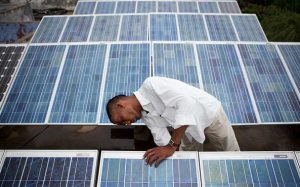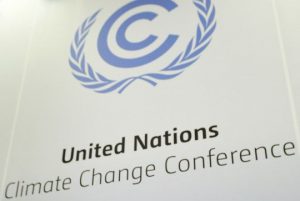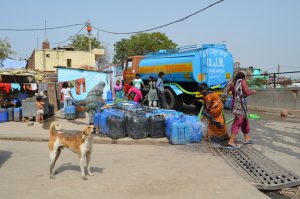India’s long-awaited national climate change plan has promised to cut the intensity of its greenhouse gas (GHG) emissions per unit of GDP by 33-35% by 2030 compared with 2005 levels. However, the target isn’t as ambitious as some international analysts had hoped for.
India – the world’s third highest GHG emitter but way down the list on per capita emissions – has promised to generate 40% of its electricity from “non-fossil fuel based energy resources by 2030 with the help of transfer of technology and low cost international finance including from Green Climate Fund (GCF)”.
The 40% includes hydropower and nuclear power. India already has a target of generating 175GW through solar and wind power by 2022. The government now plans to float infrastructure bonds to the tune of US$794 million, particularly for renewable energy projects. India’s electricity demand of 776 terawatt hours (TWh) in 2012 is estimated to rise more than threefold to 2,499 TWh by 2030.
India submitted its Intended Nationally Determined Contribution, otherwise known as an INDC, almost literally at the last hour of the United Nations Framework Convention on Climate Change (UNFCCC) deadline. In it, the Indian government also promised “to create an additional carbon sink of 2.5 to 3 billion tonnes of CO2 (carbon dioxide) equivalent through additional forest and tree cover by 2030”.
The approximate cost of India’s climate action to curb GHG emissions and adapt to the impacts of climate change is estimated at US$2.5 trillion.
By and large, independent analysts were supportive of the INDC, but said some crucial measures are targets lacked detail.
Talking about the emissions intensity reduction target, Siddharth Pathak of Climate Action Network said: “It is not clear whether these are carbon emissions or GHG emissions. In China’s INDC they clearly state that it is carbon dioxide emissions per unit of GDP.” Carbon dioxide is the most significant GHG, but there are others, including methane, water vapour and some refrigerant gases.
Sandeep Chachra, Executive Director of ActionAid India, said that, despite the huge challenges facing India as a developing countries, the country had put forward a climate action plan “far superior” to those proposed by the US and EU. He added: “Its ambitious focus on energy efficiency and dramatic increase in renewable energy deserves credit, but must lead to enhanced energy access for the poor. This clearly puts the onus on developed countries to meet their obligations of providing public finance and technology transfer to developing and least developed countries.”
Some international analysts referred to a number of recent studies that recommended an emissions intensity reduction target of 35-50% for India. They said the declared target of 33-35% was definitely achievable and India may well surpass it. In 2009, India promised to reduce its emissions intensity per unit of GDP by 20-25% by 2020 from 2005 levels. Its climate plan says the country has so far achieved a 12% reduction from 2005 levels by 2010.
India’s 2008 National Action Plan on Climate Change (NAPCC) had eight missions to deal with climate change and its effects. The new plan released on Friday confirms what the Narendra Modi has been saying for some time – four missions or programmes will be added. These are for wind energy, health, waste-to-energy and coastal areas. The INDC says the government is also redesigning the National Water Mission and the National Mission on Sustainable Agriculture. However, it does not contain any details on any of the new missions.
As expected, the INDC placed a lot of emphasis on adaptation to climate change. India said it would enhance investments “in sectors vulnerable to climate change, particularly agriculture, water resources, Himalayan region, coastal regions, health and disaster management”.
The country is setting up a National Adaptation Fund with capitalisation of US$55.6 million. It is also setting up a National Disaster Relief fund.
INDCs – to be submitted by all UNFCCC member countries – will form the bedrock of a global agreement to fight climate change. The agreement is expected to be signed at the Paris summit this December. By the morning of October 2, 120 of the 194 UNFCCC member countries had submitted their INDCs, and the number was changing almost by the hour. Independent analysis showed that INDCs submitted by October 1 – including most major emitters – could limit average global temperature rise to 2.7 degrees C by 2100, above the 2degree C limit agreed by all governments in 2010.
Wanted: money and technology
India’s INDC raises a prickly issue still unresolved on the road to Paris – the extent to which rich countries will help others to reduce their emissions and deal with climate change effects. It says the government wants “to mobilise domestic and new and additional funds from developed countries to implement the above mitigation and adaptation actions in view of the resource required and the resource gap”.
Throwing its weight behind a strong deal in Paris, the government has said [or says? Is this in the INDC or from earlier? By saying “has said’ sounds like it is earlier], “The successful implementation of INDC is contingent upon an ambitious global agreement including additional means of implementation to be provided by developed country parties, technology transfer and capacity building.”
These “means of implementation” are going to be costly. “Preliminary estimates indicate that India would need around US$206 billion (at 2014-15 prices) between 2015 and 2030 for implementing adaptation actions in agriculture, forestry, fisheries infrastructure, water resources and ecosystems,” the INDC says.
“Apart from this there will be additional investments needed for strengthening resilience and disaster management. An Asian Development Bank study on assessing the costs of climate change adaptation in South Asia indicates that approximate adaptation cost for India in the energy sector alone would roughly be about US$7.7 billion in 2030s. The report also projects the economic damage and losses in India from climate change to be around 1.8% of its GDP annually by 2050.
“Mitigation requirements are even more enormous. Estimates by NITI Aayog (National Institution for Transforming India) indicate that the mitigation activities for moderate low carbon development would cost around US$834 billion till 2030 at 2011 prices.” NITI Aayog is the successor to India’s Planning Commission.
The government has not yet finalised how much climate money India will need from rich nations. According to the INDC, a figure in the region of US$2.5 trillion (at 2014-15 prices) will be required for meeting India’s climate change actions between now and 2030.
As for the other big issue dividing developed and developing countries, India has reiterated its demand for the transfer of clean technologies “free of Intellectual Property Rights (IPR) costs to developing countries. IPR costs can also be borne from the GCF through a separate window.”
The steps
India’s INDC listed several steps that are apart from the new measures under its 2008 action plan. Officials had hinted earlier this year that India may submit two INDC figures – one based on what it could do on its own, and the other what it could do if it received all the help on finance and technology it wanted from developed countries. The INDC that has been submitted does not follow that pattern, but makes it very clear that India wants substantial contributions from rich nations.
The steps include:
• Introducing new, more efficient and cleaner technologies in thermal power generation;
• Promoting renewable energy generation and increasing the share of alternative fuels in overall fuel mix;
• Introducing new, more efficient and cleaner technologies in thermal power generation;
• Reducing emissions from transportation sector;
• Promoting energy efficiency in the economy, notably in industry, transportation, buildings and appliances;
• Reducing emissions from waste;
• Developing climate resilient infrastructure;
• Full implementation of Green India Mission and other programmes of afforestation; and
• Planning and implementation of actions to enhance climate resilience and reduce vulnerability to climate change.








